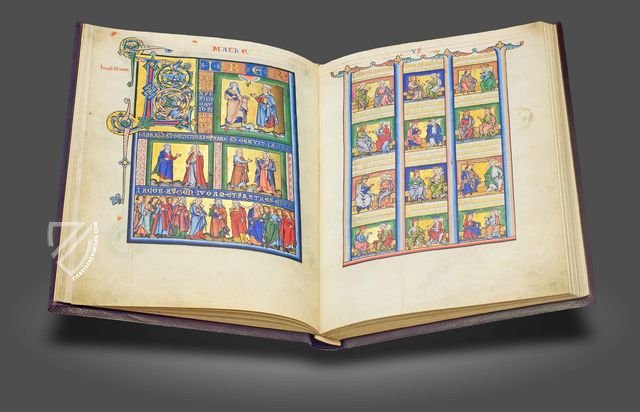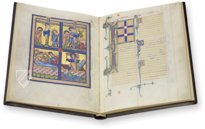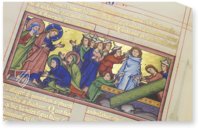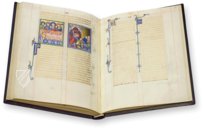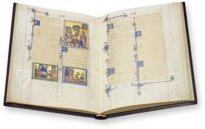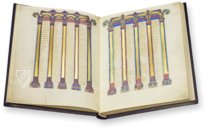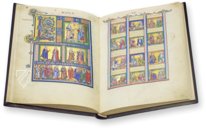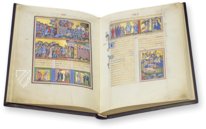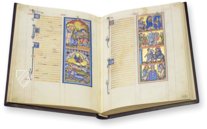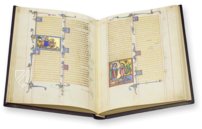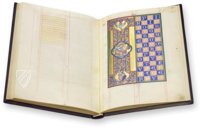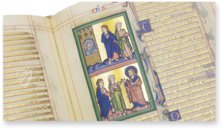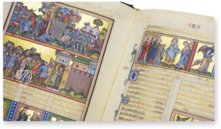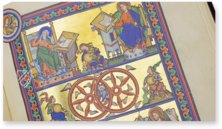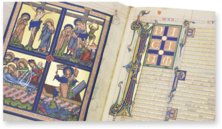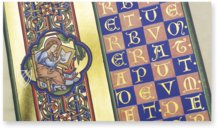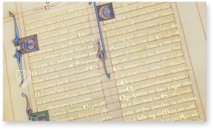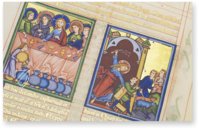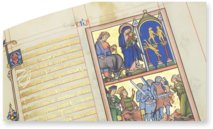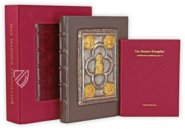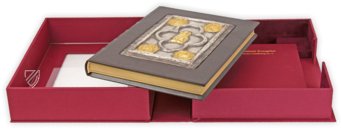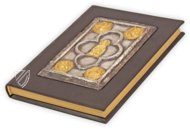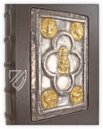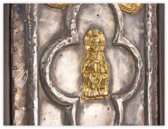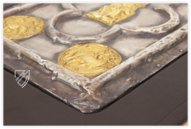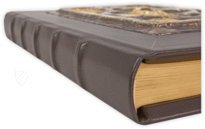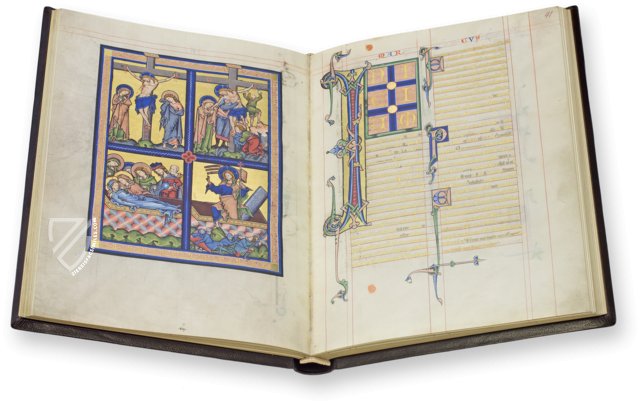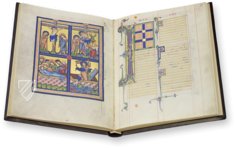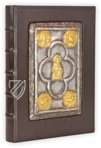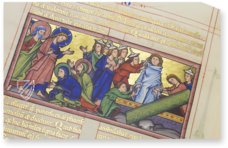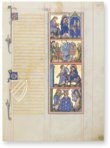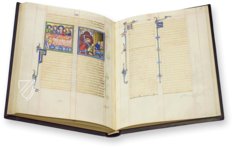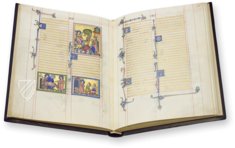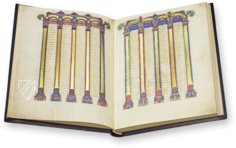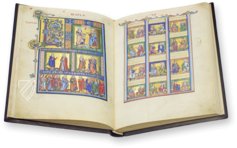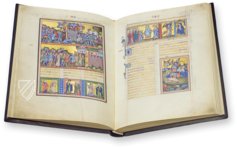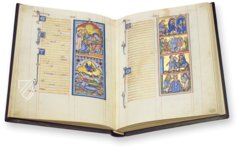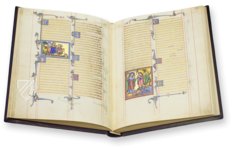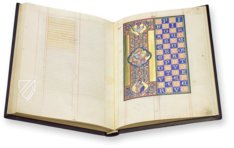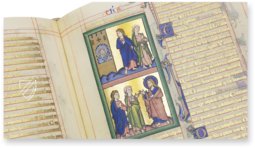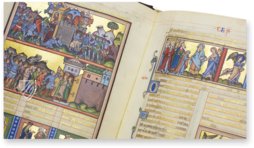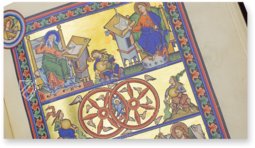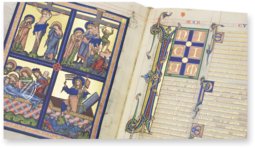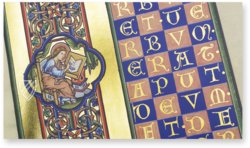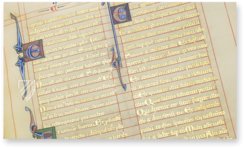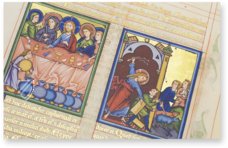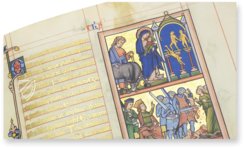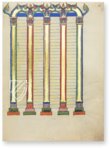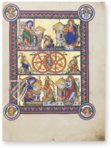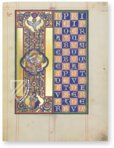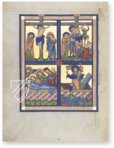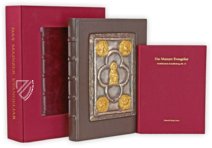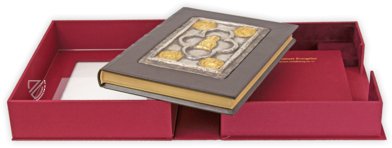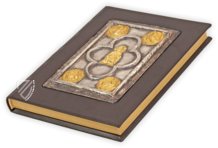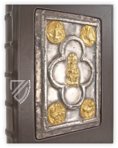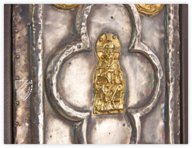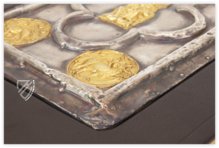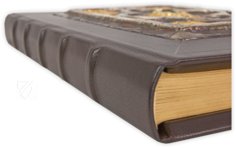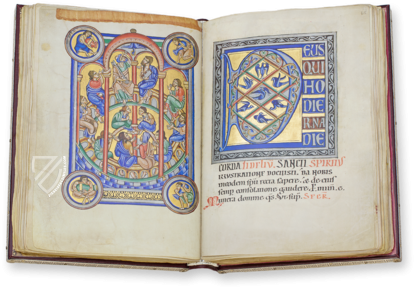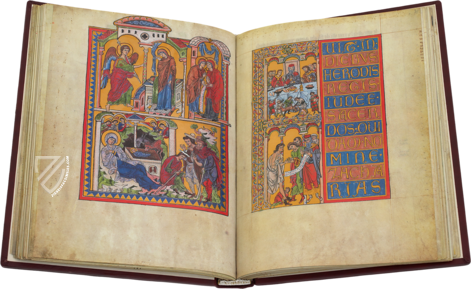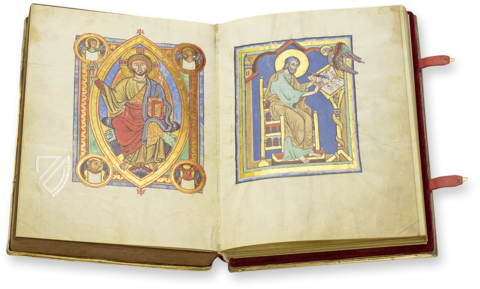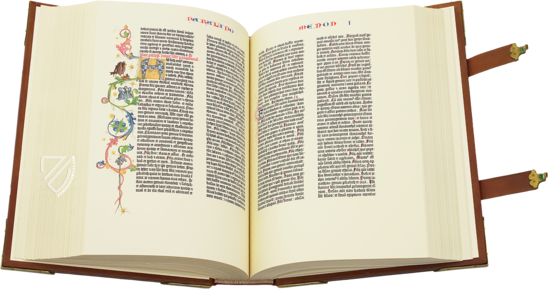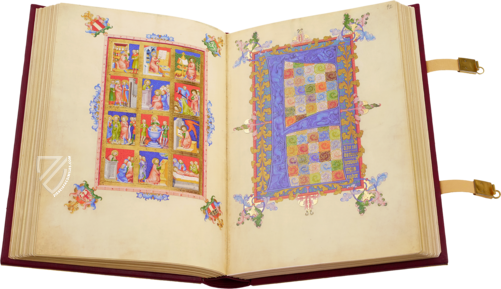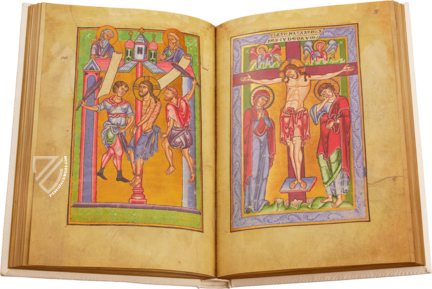Mainz Gospels
(3,000€ - 7,000€)
An influential masterpiece: the Mainz Gospels is completely written using gold ink in a script that was used as a model by Johannes Gutenberg for creating his printed typeface. Furthermore, its famous Zackenstil or “jagged style” miniatures are a highpoint of the 13th century and are reminiscent of the grand Gospel books produced by Carolingian and Byzantine artists. However, these 71 masterful miniatures with burnished gold backgrounds – some of them full-page – possess a dynamism and naturalism that its predecessors lack. From the quality of the materials to the refinement and uniformity of the artistry, this early Gothic masterpiece is a wonder to behold.
Mainz Gospels
The Mainz Gospels represents one of the most important testimonies of 13th century German book art. The masterful manuscript is so richly and artistically hand decorated with gold and silver that only one tiny group of people could have made it. So the assumption can be made that the then archbishop of the prosperous and influential diocese of Mainz must have been either the patron of this gold codex or was gifted it. The treasured book was a part of the treasury of Mainz Cathedral from its completion in 1250 until it was attained by the Aschaffenburg library in Lower Franconia during the secularization of 1803. The book is still guarded as a treasure there today.
Sacred Text – Golden Script
Like all gospels, the Mainz Gospels contains the good news of the New Testament. It was written in pure gold ink in order to emphasize the holiness of the Gospels according to Mathew, Mark, Luke, and John. In contrast, the less-holy texts before and after, the canon tables and commentary, are written in black and clearly indicate where the reader ought to direct his attention. The Textura script with which the Mainz Gospels was written is considered to be the most beautiful script of the Gothic era. Its symmetry is a further indication of the weight of the holy words. It was not for nothing that even Gutenberg stuck closely to this calligraphy as he was making the nearly 300 letters required for his famous bible. The splendor in imagery and material of Mainz Gospels clearly refers back to the heyday of gospels from the Carolingian and Ottonian epochs.
Early Gothic “Zackenstil”
The iconography clearly indicates the heritage of the Reichenau and Echternach schools of painting: luminous colors set against gold backgrounds and clear contours – such as the lavish picture cycle of the life of Christ. No less than 71 miniatures, some full-page, were created by the anonymous painter, which visualize the stories of Jesus’ life and suffering from the cradle to the Resurrection. The Mainz Gospels stands alone in its opulence among the book treasures of the 13th century. During this time period, as the Gothic style was conquering France and Germany, the painting also went in new directions. The so-called early-Gothic “Zackenstil” was among these new inventions. This distinguished itself with the snappy contours of the garments of the persons depicted. Another change was the transition of the pictures from the horizontal Romanesque orientation to the vertical Gothic: painters of the 10th and 11th centuries were anxious to depict everything important horizontally in one level, so the masters of the 12th century decided to change in order to allow their figures to reach upwards. They benefited as a result because it gave them opportunities for a new, almost relief-like painting technique. This splendor is matched by the text, where one finds finely drawn canon tables and over 300 large and small golden and embellished initials.
Bathed in Light like a Gothic Cathedral
The golden codex from Mainz enchants as soon as one lays their eyes upon it because of its glimmering gold. The golden miniatures correspond to the reflective text written in gold ink. Not only are many of them painted against a gold background, they also feature gorgeous pastel colors: violet and blue, pink and purple, the corresponding silk, and intensive full color. All of that comes together in a rush of color, which accentuates the gold even more.
Codicology
- Alternative Titles
- Mainzer Evangeliar
- Size / Format
- 200 pages / 35.3 × 27.0 cm
- Origin
- Germany
- Date
- 1230–1250
- Style
- Genre
- Language
- Script
- Gothic Textura
- Illustrations
- 71 miniatures (some full-page) and 300+ decorative initials
- Content
- The Gospels of Matthew, Mark, Luke, and John written entirely in gold ink
- Patron
- Archbishop of Mainz
Mainz Gospels
Incipit Page: Gospel of John
This page introducing the Gospel of John is a marvelous mixture of gold leaf and strong primary colors, all executed with incredible symmetry and attention to detail. John the Apostle is seated within the “I” initial, hard at work, while the famous first words of the unique Gospel appear to the right: In principio erat verbum et verbum erat apud Deum et Deus erat verbum “In the beginning was the Word, and the Word was with God, and the Word was God.” (Jn. 1:1)
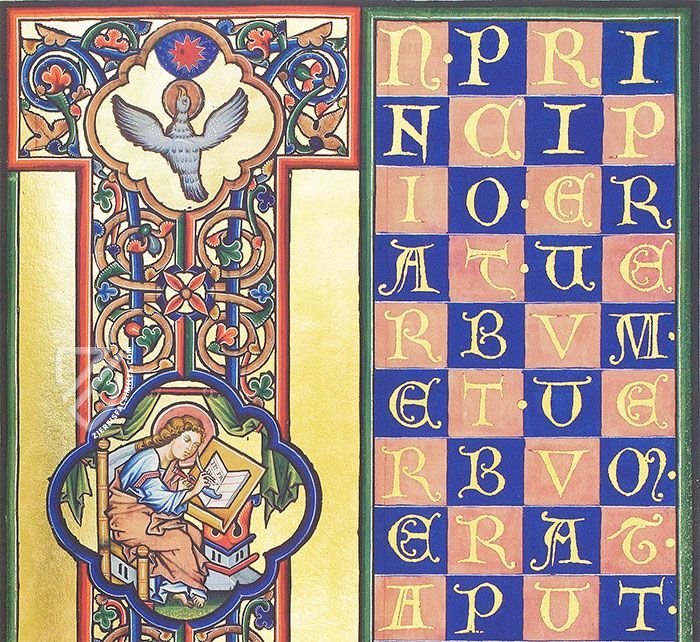
Mainz Gospels
Death, Burial and Resurrection of Christ
The cycle most central to Christian theology ending with Christ’s triumph over death is normally broken up into separate miniatures, but is united into a single page here in order to impart a feeling of completeness and dynamism. Part of this dynamism also comes from exceeding the frames: the cross overlaps with the frame at the top, as does Christ’s staff in the lower right quadrant, making them appear as though they are coming out from the page.
The composition is a masterpiece of the Zackenstil or “jagged style”, an early Gothic form of illumination particular to Germany. It is a highly stylized development of Roman and Byzantine forms characterized by garments with sharp folds and contours, emotionally expressive faces, and burnished gold backgrounds.
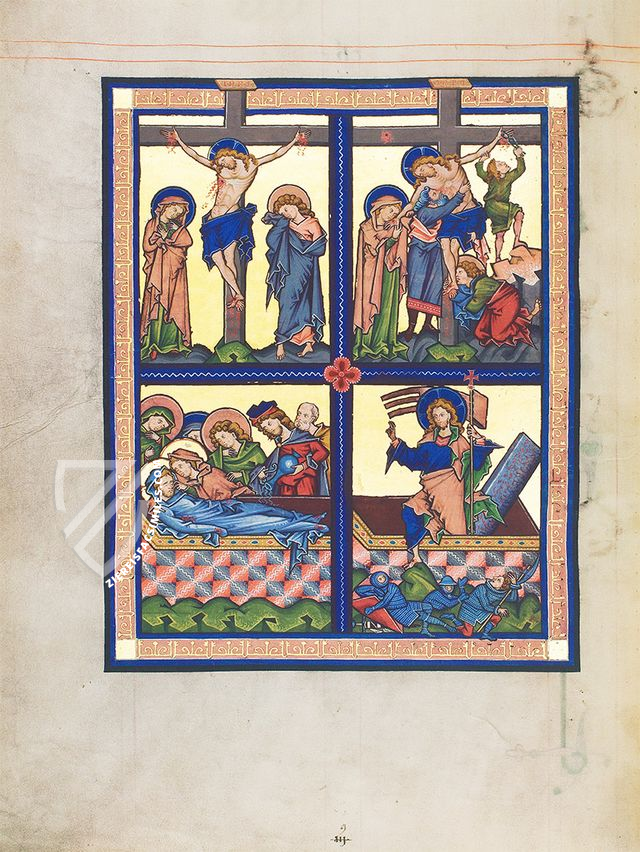
#1 Mainzer Evangeliar
Language: German
(3,000€ - 7,000€)
- Treatises / Secular Books
- Apocalypses / Beatus
- Astronomy / Astrology
- Bestiaries
- Bibles / Gospels
- Chronicles / History / Law
- Geography / Maps
- Saints' Lives
- Islam / Oriental
- Judaism / Hebrew
- Single Leaf Collections
- Leonardo da Vinci
- Literature / Poetry
- Liturgical Manuscripts
- Medicine / Botany / Alchemy
- Music
- Mythology / Prophecies
- Psalters
- Other Religious Books
- Games / Hunting
- Private Devotion Books
- Other Genres
- Afghanistan
- Armenia
- Austria
- Belgium
- Belize
- Bosnia and Herzegovina
- China
- Colombia
- Costa Rica
- Croatia
- Cyprus
- Czech Republic
- Denmark
- Egypt
- El Salvador
- Ethiopia
- France
- Germany
- Greece
- Guatemala
- Honduras
- Hungary
- India
- Iran
- Iraq
- Israel
- Italy
- Japan
- Jordan
- Kazakhstan
- Kyrgyzstan
- Lebanon
- Liechtenstein
- Luxembourg
- Mexico
- Morocco
- Netherlands
- Palestine
- Panama
- Peru
- Poland
- Portugal
- Romania
- Russia
- Serbia
- Spain
- Sri Lanka
- Sweden
- Switzerland
- Syria
- Tajikistan
- Turkey
- Turkmenistan
- Ukraine
- United Kingdom
- United States
- Uzbekistan
- Vatican City
- A. Oosthoek, van Holkema & Warendorf
- Aboca Museum
- Ajuntament de Valencia
- Akademie Verlag
- Akademische Druck- u. Verlagsanstalt (ADEVA)
- Aldo Ausilio Editore - Bottega d’Erasmo
- Alecto Historical Editions
- Alkuin Verlag
- Almqvist & Wiksell
- Amilcare Pizzi
- Andreas & Andreas Verlagsbuchhandlung
- Archa 90
- Archiv Verlag
- Archivi Edizioni
- Arnold Verlag
- ARS
- Ars Magna
- ArtCodex
- AyN Ediciones
- Azimuth Editions
- Badenia Verlag
- Bärenreiter-Verlag
- Belser Verlag
- Belser Verlag / WK Wertkontor
- Benziger Verlag
- Bernardinum Wydawnictwo
- BiblioGemma
- Biblioteca Apostolica Vaticana (Vaticanstadt, Vaticanstadt)
- Bibliotheca Palatina Faksimile Verlag
- Bibliotheca Rara
- Boydell & Brewer
- Bramante Edizioni
- Bredius Genootschap
- Brepols Publishers
- British Library
- C. Weckesser
- Caixa Catalunya
- Canesi
- CAPSA, Ars Scriptoria
- Caratzas Brothers, Publishers
- Carus Verlag
- Casamassima Libri
- Centrum Cartographie Verlag GmbH
- Chavane Verlag
- Christian Brandstätter Verlag
- Circulo Cientifico
- Club Bibliófilo Versol
- Club du Livre
- CM Editores
- Collegium Graphicum
- Collezione Apocrifa Da Vinci
- Comissão Nacional para as Comemorações dos Descobrimentos Portugueses
- Coron Verlag
- Corvina
- CTHS
- D. S. Brewer
- Damon
- De Agostini/UTET
- De Nederlandsche Boekhandel
- De Schutter
- Deuschle & Stemmle
- Deutscher Verlag für Kunstwissenschaft
- DIAMM
- Droz
- E. Schreiber Graphische Kunstanstalten
- Ediciones Boreal
- Ediciones Grial
- Ediclube
- Edições Inapa
- Edilan
- Editalia
- Edition Deuschle
- Edition Georg Popp
- Edition Leipzig
- Edition Libri Illustri
- Editiones Reales Sitios S. L.
- Éditions de l'Oiseau Lyre
- Editions Medicina Rara
- Editorial Casariego
- Editorial Mintzoa
- Editrice Antenore
- Editrice Velar
- Edizioni Edison
- Egeria, S.L.
- Eikon Editores
- Electa
- Emery Walker Limited
- Enciclopèdia Catalana
- Eos-Verlag
- Ephesus Publishing
- Ernst Battenberg
- Eugrammia Press
- Extraordinary Editions
- Fackelverlag
- Facsimila Art & Edition
- Facsimile Editions Ltd.
- Facsimilia Art & Edition Ebert KG
- Faksimile Verlag
- Feuermann Verlag
- Folger Shakespeare Library
- Franco Cosimo Panini Editore
- Friedrich Wittig Verlag
- Fundación Hullera Vasco-Leonesa
- G. Braziller
- Gabriele Mazzotta Editore
- Gebr. Mann Verlag
- Gesellschaft für graphische Industrie
- Getty Research Institute
- Giovanni Domenico de Rossi
- Giunti Editore
- Graffiti
- Grafica European Center of Fine Arts
- Guido Pressler
- Guillermo Blazquez
- Gustav Kiepenheuer
- H. N. Abrams
- Harrassowitz
- Harvard University Press
- Helikon
- Hendrickson Publishers
- Henning Oppermann
- Herder Verlag
- Hes & De Graaf Publishers
- Hoepli
- Holbein-Verlag
- Houghton Library
- Hugo Schmidt Verlag
- Idion Verlag
- Il Bulino, edizioni d'arte
- ILte
- Imago
- Insel Verlag
- Insel-Verlag Anton Kippenberger
- Instituto de Estudios Altoaragoneses
- Instituto Nacional de Antropología e Historia
- Introligatornia Budnik Jerzy
- Istituto dell'Enciclopedia Italiana - Treccani
- Istituto Ellenico di Studi Bizantini e Postbizantini
- Istituto Geografico De Agostini
- Istituto Poligrafico e Zecca dello Stato
- Italarte Art Establishments
- Jan Thorbecke Verlag
- Johnson Reprint Corporation
- Josef Stocker
- Josef Stocker-Schmid
- Jugoslavija
- Karl W. Hiersemann
- Kasper Straube
- Kaydeda Ediciones
- Kindler Verlag / Coron Verlag
- Kodansha International Ltd.
- Konrad Kölbl Verlag
- Kurt Wolff Verlag
- La Liberia dello Stato
- La Linea Editrice
- La Meta Editore
- Lambert Schneider
- Landeskreditbank Baden-Württemberg
- Leo S. Olschki
- Les Incunables
- Liber Artis
- Library of Congress
- Libreria Musicale Italiana
- Lichtdruck
- Lito Immagine Editore
- Lumen Artis
- Lund Humphries
- M. Moleiro Editor
- Maison des Sciences de l'homme et de la société de Poitiers
- Manuscriptum
- Martinus Nijhoff
- Maruzen-Yushodo Co. Ltd.
- MASA
- Massada Publishers
- McGraw-Hill
- Metropolitan Museum of Art
- Militos
- Millennium Liber
- Müller & Schindler
- Nahar - Stavit
- Nahar and Steimatzky
- National Library of Wales
- Neri Pozza
- Nova Charta
- Oceanum Verlag
- Odeon
- Orbis Mediaevalis
- Orbis Pictus
- Österreichische Staatsdruckerei
- Oxford University Press
- Pageant Books
- Parzellers Buchverlag
- Patrimonio Ediciones
- Pattloch Verlag
- PIAF
- Pieper Verlag
- Plon-Nourrit et cie
- Poligrafiche Bolis
- Presses Universitaires de Strasbourg
- Prestel Verlag
- Princeton University Press
- Prisma Verlag
- Priuli & Verlucca, editori
- Pro Sport Verlag
- Propyläen Verlag
- Pytheas Books
- Quaternio Verlag Luzern
- Reales Sitios
- Recht-Verlag
- Reichert Verlag
- Reichsdruckerei
- Reprint Verlag
- Riehn & Reusch
- Roberto Vattori Editore
- Rosenkilde and Bagger
- Roxburghe Club
- Salerno Editrice
- Saltellus Press
- Sandoz
- Sarajevo Svjetlost
- Schöck ArtPrint Kft.
- Schulsinger Brothers
- Scolar Press
- Scrinium
- Scripta Maneant
- Scriptorium
- Shazar
- Siloé, arte y bibliofilia
- SISMEL - Edizioni del Galluzzo
- Sociedad Mexicana de Antropología
- Société des Bibliophiles & Iconophiles de Belgique
- Soncin Publishing
- Sorli Ediciones
- Stainer and Bell
- Studer
- Styria Verlag
- Sumptibus Pragopress
- Szegedi Tudomànyegyetem
- Taberna Libraria
- Tarshish Books
- Taschen
- Tempus Libri
- Testimonio Compañía Editorial
- Thames and Hudson
- The Clear Vue Publishing Partnership Limited
- The Facsimile Codex
- The Folio Society
- The Marquess of Normanby
- The Richard III and Yorkist History Trust
- Tip.Le.Co
- TouchArt
- TREC Publishing House
- TRI Publishing Co.
- Trident Editore
- Tuliba Collection
- Typis Regiae Officinae Polygraphicae
- Union Verlag Berlin
- Universidad de Granada
- University of California Press
- University of Chicago Press
- Urs Graf
- Vallecchi
- Van Wijnen
- VCH, Acta Humaniora
- VDI Verlag
- VEB Deutscher Verlag für Musik
- Verlag Anton Pustet / Andreas Verlag
- Verlag Bibliophile Drucke Josef Stocker
- Verlag der Münchner Drucke
- Verlag für Regionalgeschichte
- Verlag Styria
- Vicent Garcia Editores
- W. Turnowski Ltd.
- W. Turnowsky
- Waanders Printers
- Wiener Mechitharisten-Congregation (Wien, Österreich)
- Wissenschaftliche Buchgesellschaft
- Wissenschaftliche Verlagsgesellschaft
- Wydawnictwo Dolnoslaskie
- Xuntanza Editorial
- Zakład Narodowy
- Zollikofer AG

